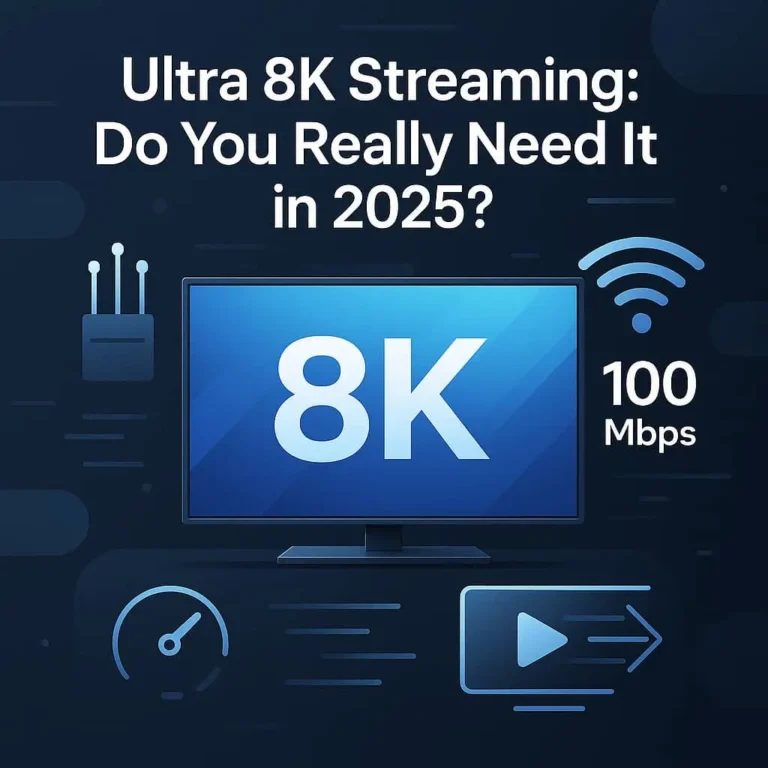Posted by admin | Nov 7,2025 | Ultra 8K Streaming

Ultr 8K Streaming: Do You Really Need It in 2025?
Ultra 8K streaming in 2025 offers stunning detail—but do you really need it? Compare 8K vs 4K, check bandwidth needs, and see if your 8K TV is worth it.
Table of Contents
1. Introduction
2. What Is 8K Streaming?
3. How 8K Differs from 4K and HD
4. The Reality of 8K in 2025
5. Internet Speed and Data Demands
6. Hardware and Cost Considerations
7. Content Availability
8. Environmental and Energy Impact
9. Who Actually Benefits from 8K?
10. Future Outlook
11. Frequently Asked Questions (FAQ)
12. Conclusion
1. Introduction
Technology never stops evolving, and neither does our appetite for sharper, more detailed visuals. After the massive success of 4K streaming, the entertainment industry is now pushing 8K resolution as the next big leap in visual quality. But in 2025, as internet speeds and display technology continue to advance, one question remains: Do you really need 8K streaming at home?
—
2. What Is 8K Streaming?
8K streaming delivers a picture resolution of 7680 x 4320 pixels — that’s four times the detail of 4K and sixteen times that of Full HD. Every frame contains more than 33 million pixels, providing incredibly lifelike depth and texture when viewed on compatible screens.
Streaming in 8K means video content is compressed using advanced codecs (like HEVC or AV1) to balance quality with manageable file sizes — though it still demands a powerful internet connection and capable hardware.
—
3. How 8K Differs from 4K and HD
While 4K (3840 x 2160) already offers stunning clarity, the jump to 8K isn’t as revolutionary to the human eye as the jump from HD to 4K was.
4K vs. 8K: The difference becomes visible mainly on very large screens (75 inches and above) or when you sit close to the display.
HD vs. 8K: The improvement is dramatic, but 8K hardware and bandwidth requirements make it impractical for most households today.
In short, while 8K technically doubles the resolution of 4K, the visual improvement in normal conditions may not justify the upgrade.
—
4. The Reality of 8K in 2025
In 2025, 8K technology has matured — but adoption remains limited.
While premium TV brands and streaming services now support 8K playback, the average viewer still doesn’t have the internet infrastructure or hardware needed to experience it fully.
Streaming giants like Netflix, Disney+, and YouTube experiment with 8K content, but most of their catalogs remain in 4K HDR, which already provides outstanding image quality.
—
5. Internet Speed and Data Demands
Ultra 8K streaming is incredibly data-hungry. To stream seamlessly:
You need at least 80–100 Mbps of stable internet bandwidth.
A single hour of 8K streaming can consume over 60–100 GB of data.
While next-generation internet services (like fiber and 5G+) can handle these speeds, data caps and network congestion still make 8K impractical for many users.
—
6. Hardware and Cost Considerations
To enjoy 8K properly, you’ll need:
An 8K-compatible TV or monitor (often costing several thousand dollars).
A streaming device or console that supports 8K decoding.
A high-speed router and HDMI 2.1 cables.
For most households, these costs outweigh the marginal visual gains — especially when 4K HDR content already looks exceptional on high-end screens.
—
7. Content Availability
Another major limitation is the lack of native 8K content.
While some sports events, documentaries, and demo reels are filmed in 8K, most movies and shows are still shot in 4K or even 2K, then upscaled to 8K. This means you’re not always seeing “true” 8K resolution, just digitally enhanced video.
—
8. Environmental and Energy Impact
Streaming in 8K consumes significantly more energy — not just on your end but across the global content delivery chain.
Data centers, routers, and network infrastructure all use more power to transmit ultra-high-resolution content.
For environmentally conscious viewers, 8K may not be the most sustainable option, especially when 4K already provides impressive clarity with a smaller carbon footprint.
—
9. Who Actually Benefits from 8K?
8K streaming can make sense for:
Professional video editors or content creators who work with ultra-high-resolution footage.
Home theater enthusiasts with large projection screens or advanced AV setups.
Tech adopters who want to future-proof their entertainment systems.
For the average viewer watching Netflix or sports on a 55-inch screen, 8K’s advantages are minimal.
—
10. Future Outlook
As technology improves, 8K streaming will become more accessible and efficient. Compression algorithms will reduce data demands, and AI-driven upscaling will enhance lower-resolution content.
However, it may take several more years before 8K becomes a mainstream standard. By that time, the focus might shift from resolution to immersive formats — like HDR+, VR, or holographic media.
—
11. Frequently Asked Questions (FAQ)
Q1: Is 8K streaming worth it right now?
Only if you own a large 8K TV and have ultra-fast, unlimited internet. Otherwise, 4K remains the best balance of quality and practicality.
Q2: Can the human eye even notice the difference between 4K and 8K?
At typical viewing distances, the difference is barely noticeable. You’ll need a massive screen or close seating to truly appreciate 8K resolution.
Q3: Which platforms support 8K streaming in 2025?
YouTube, Netflix (on select titles), and Amazon Prime Video have started offering limited 8K content, but the majority of shows are still in 4K.
Q4: Does 8K streaming require special cables?
Yes — HDMI 2.1 or higher is needed for true 8K playback without compression loss.
Q5: Is 8K bad for the environment?
It’s not inherently “bad,” but it uses more energy and data than 4K, contributing to a higher carbon footprint if powered by non-renewable sources.
—
12. Conclusion
In 2025, 8K streaming represents the cutting edge of visual technology — but for most viewers, it’s not a necessity. The costs, data requirements, and limited content make it more of a luxury than a must-have.
Unless you’re a filmmaker, a tech enthusiast, or own a giant screen, 4K HDR streaming remains the perfect balance between realism, performance, and sustainability.
Thank you for choosing our website 💛
We’re always happy to serve you and provide the best experience with our ott playlist IPTV.
Feel free to contact us anytime for support or inquiries.
